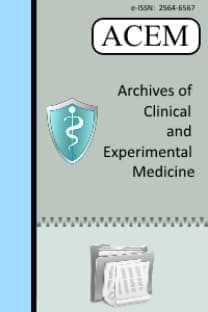Timozin beta-4 A/T polimorfizmi ve akut koroner sendrom riski
Timozin beta-4 (Tβ4) A/T, polimorfizm, akut koroner sendrom, PCR-RFLP
Thymosin beta-4 A/T polymorphism and acute coronary syndrome risk
Thymosin Beta-4 A/T, polymorphism, acute coronary syndrome, PCR-RFLP,
___
- 1.Moodie DS. The Global Burden of Cardiovascular Disease. Congenit Heart Dis. 2016; 11:213.
- 2.American College of Cardiology/American Heart Association Task Force on Practice G. ACC/AHA guidelines for the management of patients with unstable angina and non-ST segment elevation myocardial infarction: executive summary and recommendations. Catheter Cardiovasc Interv. 2000; 51:505-21.
- 3.Coskun A, Eren SH, Korkmaz I, Guven FMK. The epidemiological and prognostic importance of the aVR lead among patients with and without ST segment elevation. Turk Gogus Kalp Damar Cerrahisi Dergisi-Turkish J Thorac Cardiovasc Surg. 2011;19:570-5.
- 4.Van de Werf F, Ardissino D, Betriu A, Cokkinos DV, Falk E, Fox KA, et al. Management of acute myocardial infarction in patients presenting with ST-segment elevation. The Task Force on the Management of Acute Myocardial Infarction of the European Society of Cardiology. Eur Heart J. 2003;24:28-66.
- 5.Kumar A, Cannon CP. Acute coronary syndromes: diagnosis and management, part I. Mayo Clin Proc. 2009;84:917-38.
- 6.Smith JN, Negrelli JM, Manek MB, Hawes EM, Viera AJ. Diagnosis and management of acute coronary syndrome: an evidence-based update. J Am Board Fam Med. 2015;28:283-93.
- 7.Shrivastava S, Srivastava D, Olson EN, DiMaio JM, Bock-Marquette I. Thymosin beta4 and cardiac repair. Ann N Y Acad Sci. 2010;1194:87-96.
- 8.Goldstein AL, Hannappel E, Kleinman HK. Thymosin beta4: actin-sequestering protein moonlights to repair injured tissues. Trends Mol Med. 2005;11:421-9.
- 9.Yesilay AB, Karakurt O, Akdemir R, Erden G, Kilic H, Acikel S, et al. Thymosin beta4 levels after successful primary percutaneous coronary intervention for acute myocardial infarction. Turk Kardiyol Dern Ars. 2011;39:654-60.
- 10.Sosne G, Qiu P, Kurpakus-Wheater M. Thymosin beta 4: A novel corneal wound healing and anti-inflammatory agent. Clin Ophthalmol. 2007;1:201-7.
- 11.Bock-Marquette I, Saxena A, White MD, Dimaio JM, Srivastava D. Thymosin beta4 activates integrin-linked kinase and promotes cardiac cell migration, survival and cardiac repair. Nature. 2004;432:466-72.
- 12.Crockford D. Development of thymosin beta4 for treatment of patients with ischemic heart disease. Ann N Y Acad Sci. 2007;1112:385-95.
- 13.Miller SA, Dykes DD, Polesky HF. A simple salting out procedure for extracting DNA from human nucleated cells. Nucleic Acids Res. 1988;16:1215.
- 14.Kilic S, Simsek E, Soner Kemal H, Yuce EI, Turkoglu C, Kayikcioglu M. The role of specialized prevention clinics for the short term follow-up of acute coronary syndromes. Turk Kardiyol Dern Ars. 2017;45:498-505.
- 15.Ozkan AA. [Acute coronary syndromes: epidemiology]. Turk Kardiyol Dern Ars. 2013;41:1-3.
- 16.Achar SA, Kundu S, Norcross WA. Diagnosis of acute coronary syndrome. Am Fam Physician. 2005;72:119-26.
- 17.Marks ED, Kumar A. Thymosin beta4: Roles in Development, Repair, and Engineering of the Cardiovascular System. Vitam Horm. 2016;102:227-49.
- 18.Pipes GT, Yang J. Cardioprotection by Thymosin Beta 4. Vitam Horm. 2016;102:209-26.
- 19.Srivastava D, Saxena A, Michael Dimaio J, Bock-Marquette I. Thymosin beta4 is cardioprotective after myocardial infarction. Ann N Y Acad Sci. 2007;1112:161-70.
- 20.Bock-Marquette I, Shrivastava S, Pipes GC, Thatcher JE, Blystone A, Shelton JM, et al. Thymosin beta4 mediated PKC activation is essential to initiate the embryonic coronary developmental program and epicardial progenitor cell activation in adult mice in vivo. J Mol Cell Cardiol. 2009;46:728-38.
- 21.Smart N, Bollini S, Dube KN, Vieira JM, Zhou B, Davidson S, et al. De novo cardiomyocytes from within the activated adult heart after injury. Nature. 2011;474:640-4.
- 22.Libby P. Molecular bases of the acute coronary syndromes. Circulation. 1995;91:2844-50.
- ISSN: 2564-6567
- Yayın Aralığı: 3
- Başlangıç: 2016
- Yayıncı: -
İşitme cihazının presbiakuzili yaşlılarda işitme engelliliğine olan etkisinin araştırılması
Dorsal yaklaşım ile Morton nöroma eksizyonu cerrahisi orta dönem sonuçları
Surgicel ® kullanımının epistaksis kontrolünde nazal tampon ile karşılaştırılması
Tevfik SÖZEN, Övsen ÖNAY, Seyit Mehmet CEYLAN
Migren hastalarında enflamatuvar belirteçlerin değerlendirilmesi
Aysel TEKESİN, ABDÜLKADİR TUNÇ
Timozin beta-4 A/T polimorfizmi ve akut koroner sendrom riski
Melike GEZEN, Ümit YILMAZ, Osman FAZLIOĞULLARI, Nesibe YİLMAZ, cem HOROZOĞLU, Arzu ERGEN, ŞAKİR ÜMİT ZEYBEK
